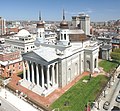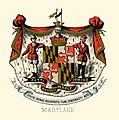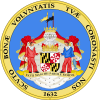Portal:Maryland
|
Maryland Portal
|
Baltimore Task Force
|
Frederick Task Force
|
Montgomery Task Force
|
WikiProject Maryland
|
|
Main page
|
Discussion
|
Introduction Maryland (US: /ˈmɛrɪlənd/ ⓘ MERR-il-ənd) is a state in the Mid-Atlantic region of the United States. The state borders Virginia to its south, West Virginia to its west, Pennsylvania to its north, Delaware to its east, the Atlantic Ocean, and the national capital of Washington, D.C. With a total area of 12,407 square miles (32,130 km2), Maryland is the ninth-smallest state by land area, and its population of 6,177,224 ranks it the 18th-most populous state and the fifth-most densely populated. Maryland's capital is Annapolis, and the most populous city is Baltimore. Occasional nicknames include Old Line State, the Free State, and the Chesapeake Bay State. It is named after Henrietta Maria, the French-born queen of England, Scotland, and Ireland during the 17th century. Maryland's coastline was first explored by Europeans in the 16th century. Prior to that, it was inhabited by several Native American tribes, mostly the Algonquian peoples and, to a lesser degree, Iroquoians and Siouans. As one of the original Thirteen Colonies, Maryland was founded by George Calvert, 1st Baron Baltimore, a Catholic convert who sought to provide a religious haven for Catholics persecuted in England. In 1632, Charles I of England granted Lord Baltimore a colonial charter, naming the colony after his wife, Henrietta Maria. Unlike the Pilgrims and Puritans, Lord Baltimore envisioned a colony where people of different religious sects would coexist under the principle of toleration. In 1649, the Maryland General Assembly passed an Act Concerning Religion, which enshrined this principle by penalizing anyone who "reproached" a fellow Marylander based on religious affiliation. Nevertheless, religious strife was common in the early years, and Catholics remained a minority, albeit in greater numbers than in any other English colony. Maryland's early settlements and population centers clustered around rivers and other waterways that empty into the Chesapeake Bay. Its economy was heavily plantation-based and centered mostly on the cultivation of tobacco. Demand for cheap labor from Maryland colonists led to the importation of numerous indentured servants and enslaved Africans. In 1760, Maryland's current boundaries took form following the settlement of a long-running border dispute with Pennsylvania. Maryland was an active participant in the events leading up to the American Revolution, and by 1776, its delegates signed the Declaration of Independence. Many of its citizens subsequently played key political and military roles in the war. Although then a slave state, Maryland remained in the Union during the American Civil War, its strategic location giving it a significant role in the conflict. After the Civil War, Maryland took part in the Industrial Revolution, driven by its seaports, railroad networks, and mass immigration from Europe. Since the 1940s, the state's population has grown rapidly, to approximately six million residents, and it is among the most densely populated U.S. states. , Maryland had the highest median household income of any state, owing in large part to its proximity to Washington, D.C., and a highly diversified economy spanning manufacturing, retail services, public administration, real estate, higher education, information technology, defense contracting, health care, and biotechnology. Maryland is one of the most multicultural states in the country; it is one of the six states where non-Whites compose a majority of the population, with the fifth-highest percentage of African Americans, and high numbers of residents born in Africa, Asia, Central America, and the Caribbean. The state's central role in U.S. history is reflected by its hosting of some of the highest numbers of historic landmarks per capita. (Full article...) This is a Featured article, which represents some of the best content on English Wikipedia..
Nicholas James Adenhart (August 24, 1986 – April 9, 2009) was an American right-handed baseball starting pitcher who played parts of two seasons in Major League Baseball (MLB) for the Los Angeles Angels of Anaheim. In just four career games, Adenhart pitched 18 innings and posted a win-loss record of 1–0. A graduate of Williamsport High School, Adenhart was highly touted as a high school prospect until an injury in his final game required Tommy John surgery. The Angels drafted him in the 14th round of the 2004 Major League Baseball draft, and began playing in their minor league system after the surgery was a success. He spent three full seasons in the minor leagues before making his major league debut on May 1, 2008. After appearing in three games, Adenhart spent the rest of 2008 in the minor leagues developing his skills, and in 2009 he earned a spot in the Angels' starting rotation. (Full article...)General imagesIn the news
On this day...This is a Good article, an article that meets a core set of high editorial standards.
Donald Zimmerman (born c. 1953) is a television analyst and former American college lacrosse coach. He became a color analyst for ESPN in May 2016 and does both high school and college lacrosse games. Prior to becoming an analyst, he served as the head coach for the UMBC Retrievers at the University of Maryland, Baltimore County for 24 years. Between 1984 and 1987, Zimmerman coached Johns Hopkins to three national championships. Zimmerman was inducted into the National Lacrosse Hall of Fame in 2017. (Full article...) Selected article - The Baltimore Orioles (also known as the O's) are an American professional baseball team based in Baltimore. The Orioles compete in Major League Baseball (MLB) as a member of the American League (AL) East Division. As one of the American League's eight charter teams in 1901, the franchise spent its first year as a major league club in Milwaukee as the Milwaukee Brewers before moving to St. Louis to become the St. Louis Browns in 1902. After 52 years in St. Louis, the franchise was purchased in 1953 by a syndicate of Baltimore business and civic interests, led by attorney and civic activist Clarence Miles and Mayor Thomas D'Alesandro Jr. The team's current owner is David Rubenstein. The Orioles' home ballpark is Oriole Park at Camden Yards, which opened in 1992 in downtown Baltimore. The oriole is the official state bird of Maryland; the name has been used by several baseball clubs in the city, including another AL charter member franchise which moved to New York in 1903 and became the Yankees. Nicknames for the team include the "O's" and the "Birds". The franchise's first World Series appearance came in 1944 when the Browns lost to the St. Louis Cardinals. The Orioles went on to make six World Series appearances from 1966 to 1983, winning three in 1966, 1970, and 1983. This era of the club featured several future Hall of Famers who would later be inducted representing the Orioles, such as third baseman Brooks Robinson, outfielder Frank Robinson, starting pitcher Jim Palmer, first baseman Eddie Murray, shortstop Cal Ripken Jr., and manager Earl Weaver. The Orioles have won a total of ten division championships (1969, 1970, 1971, 1973, 1974, 1979, 1983, 1997, 2014, 2023), seven pennants (1944 while in St. Louis, 1966, 1969, 1970, 1971, 1979, 1983), and three wild card berths (1996, 2012, 2016). The franchise was the last charter member of the American League to win a pennant, and the last charter member to win a World Series. (Full article...)Did you know?

SubcategoriesSelect [+] to view subcategories
TopicsRelated portalsAssociated WikimediaThe following Wikimedia Foundation sister projects provide more on this subject:
Discover Wikipedia using portals |























































